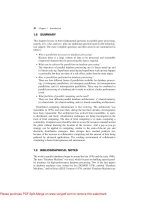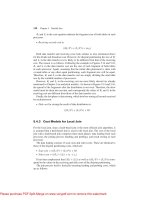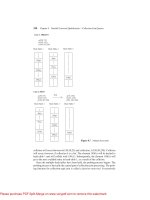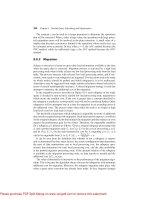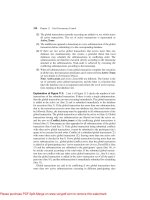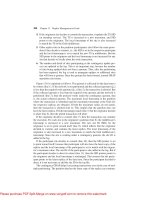C 7 and NET core 2 0 high performance build highly performant, multi threaded, and concurrent applications using c 7 and NET core 2 0
Bạn đang xem bản rút gọn của tài liệu. Xem và tải ngay bản đầy đủ của tài liệu tại đây (8.2 MB, 382 trang )
C# 7 and .NET Core 2.0 High Performance
Build highly performant, multi-threaded, and concurrent applications using C# 7 and .NET Core 2.0
Ovais Mehboob Ahmed Khan
BIRMINGHAM - MUMBAI
C# 7 and .NET Core 2.0 High Performance
Copyright © 2018 Packt Publishing
All rights reserved. No part of this book may be reproduced, stored in a retrieval system, or transmitted in any form or by any means,
without the prior written permission of the publisher, except in the case of brief quotations embedded in critical articles or reviews.
Every effort has been made in the preparation of this book to ensure the accuracy of the information presented. However, the
information contained in this book is sold without warranty, either express or implied. Neither the authors, nor Packt Publishing or its
dealers and distributors, will be held liable for any damages caused or alleged to have been caused directly or indirectly by this book.
Packt Publishing has endeavored to provide trademark information about all of the companies and products mentioned in this book by the
appropriate use of capitals. However, Packt Publishing cannot guarantee the accuracy of this information.
Commissioning Editor: Merint Mathew
Acquisition Editor: Chaitanya Nair
Content Development Editor: Anugraha Arunagiri
Technical Editor: Jijo Maliyekal
Copy Editor: Safis Editing
Project Coordinator: Ulhas Kambali
Proofreader: Safis Editing
Indexer: Tejal Daruwale Soni
Graphics: Tania Dutta
Production Coordinator: Deepika Naik
First published: April 2018
Production reference: 1240418
Published by Packt Publishing Ltd.
Livery Place
35 Livery Street
Birmingham
B3 2PB, UK.
ISBN 978-1-78847-004-9
www.packtpub.com
mapt.io
Mapt is an online digital library that gives you full access to over 5,000 books and videos, as well as
industry leading tools to help you plan your personal development and advance your career. For more
information, please visit our website.
Why subscribe?
Spend less time learning and more time coding with practical eBooks and Videos from over
4,000 industry professionals
Improve your learning with Skill Plans built especially for you
Get a free eBook or video every month
Mapt is fully searchable
Copy and paste, print, and bookmark content
PacktPub.com
Did you know that Packt offers eBook versions of every book published, with PDF and ePub files
available? You can upgrade to the eBook version at www.PacktPub.com and as a print book customer, you
are entitled to a discount on the eBook copy. Get in touch with us at for more
details.
At www.PacktPub.com, you can also read a collection of free technical articles, sign up for a range of free
newsletters, and receive exclusive discounts and offers on Packt books and eBooks.
Contributors
About the author
Ovais Mehboob Ahmed Khan is a seasoned programmer and solution architect with over 14 years
of software development experience. He has worked in organizations across Pakistan, the USA, and
the Middle East. Currently, he is working for a government entity based in Dubai. A Microsoft MVP,
he specializes mainly in Microsoft .NET, the cloud and web development. He has published technical
articles on MSDN, TechNet, personal blog, and he has authored two other books published by Packt:
JavaScript for .NET Developers and Enterprise Application Architecture with .NET Core.
I would like to thank my family for supporting me, especially my mother, wife, and brother, who have always encouraged me in
every goal of my life. My father, may he rest in peace, would have been proud of my achievements.
About the reviewer
Jalpesh Vadgama has been working on technologies like .NET such as MVC, ASP.NET Core, Web
Forms, and REST APIs for over 14 years now. Experienced in open source server-side technologies
such as Node.js, he has worked with frameworks such as jQuery, Knockout.js, Angular, React.js and
Vue. He has been awarded the Microsoft MVP award six times for his technical contribution to .NET
and has delivered over 50 Enterprise-level applications using .NET technologies. He has also been
using software development methodologies such as Agile, Scrum, and Waterfall for quite a while.
I would like to thank my wife and family for their support.
Packt is searching for authors like you
If you're interested in becoming an author for Packt, please visit authors.packtpub.com and apply today.
We have worked with thousands of developers and tech professionals, just like you, to help them
share their insight with the global tech community. You can make a general application, apply for a
specific hot topic that we are recruiting an author for, or submit your own idea.
Table of Contents
Title Page
Copyright and Credits
C# 7 and .NET Core 2.0 High Performance
Packt Upsell
Why subscribe?
PacktPub.com
Contributors
About the author
About the reviewer
Packt is searching for authors like you
Preface
Who this book is for
What this book covers
To get the most out of this book
Download the example code files
Download the color images
Conventions used
Get in touch
Reviews
1.
What's New in .NET Core 2 and C# 7?
Evolution of .NET
New improvements in .NET Core 2.0
Performance improvements
RyuJIT compiler in .NET Core
Profile guided optimization
Simplified packaging
Upgrading path from .NET Core 1.x to 2.0
1. Install .NET Core 2.0
2. Upgrade TargetFramework
3. Update .NET Core SDK version
4. Update .NET Core CLI
Changes in ASP.NET Core Identity
Exploring .NET Core CLI and New Project Templates
Understanding .NET Standard
Versioning of .NET Standard
New improvements in .NET Standard 2.0
More APIs in .NET Standard 2.0
Compatibility mode
Creating a .NET Standard library
What comes with ASP.NET Core 2.0
ASP.NET Core Razor Pages
Automatic Page and View compilation on publishing
Razor support for C# 7.1
Simplified configuration for Application Insights
Pooling connections in Entity Framework Core 2.0
New features in C# 7.0
Tuples
Patterns
Constant pattern
Type pattern
Var pattern
Reference returns
Expression bodied member extended
Creating Local Functions
Out variables
Async Main
Writing quality code
Summary
2.
Understanding .NET Core Internals and Measuring Performance
.NET Core internals
CoreFX
CoreCLR
Understanding MSIL, CLI, CTS, and CLS
How the CLR works
From compilation to execution – Under the hood
Garbage collection
Generations in GC
.NET Native and JIT compilation
Utilizing multiple cores of the CPU for high performance
How releasing builds increases performance
Benchmarking .NET Core 2.0 applications
Exploring BenchmarkDotNet
How it works
Setting parameters
Memory diagnostics using BenchmarkDotnet
Adding configurations
Summary
3.
Multithreading and Asynchronous Programming in .NET Core
Multithreading versus asynchronous programming
Multithreading in .NET Core
Multithreading caveats
Threads in .NET Core
Creating threads in .NET Core
Thread lifetime
The thread pool in .NET
Thread synchronization
Monitors
Task parallel library (TPL)
Creating a task using TPL
Task-based asynchronous pattern (TAP)
Naming convention
Return type
Parameters
Exceptions
Task status
Task cancellation
Task progress reporting
Implementing TAP using compilers
Implementing TAP with greater control over Task
Design patterns for parallel programming
Pipeline pattern
Dataflow pattern
Producer/consumer pattern
Parallel.ForEach
Parallel LINQ (PLINQ)
Summary
4.
Data Structures and Writing Optimized Code in C#
What are data structures?
Understanding the use of Big O notation to measure the performance and complexity of an algorithm
Logarithms
Choosing the right data structure for performance optimization
Arrays
Lists
Stacks
Queue
Linked lists
Singly linked lists
Doubly linked lists
Circular linked lists
Dictionaries, hashtables, and hashsets
Generic lists
Best practices in writing optimized code in C#
Boxing and unboxing overhead
String concatenation
Exception handling
For and foreach
Delegates
Summary
5.
Designing Guidelines for .NET Core Application Performance
Coding principles
Naming convention
Code comments
One class per file
One logic per method
Design principles
KISS (Keep It Simple, Stupid)
YAGNI (You Aren't Gonna Need It)
DRY (Don't Repeat Yourself)
Separation of Concerns (SoC)
SOLID principles
Single Responsibility Principle
Open Closed principle
Parameters
Inheritance
Composition
Liskov principle
The Interface Segregation principle
The Dependency Inversion principle
Caching
Data structures
Communication
Using lighter interfaces
Minimizing message size
Queuing communication
Resource management
Avoiding improper use of threads
Disposing objects in a timely fashion
Acquiring resources when they are required
Concurrency
Summary
6.
Memory Management Techniques in .NET Core
Memory allocation process overview
Analysing CLR internals through the SOS debugger in .NET Core
Memory fragmentation
Avoiding finalizers
Best practices for disposing of objects in .NET Core
Introduction to the IDisposable interface
What are unmanaged resources?
Using IDisposable
When to implement the IDisposable interface
Finalizer and Dispose
Summary
7.
Securing and Implementing Resilience in .NET Core Applications
Introduction to resilient applications
Resilient policies
Reactive policies
Implementing the retry pattern
Implementing circuit breaker
Wrapping the circuit breaker with retry
Fallback policy with circuit breaker and retry
Proactive policies
Implementing timeout
Implementing caching
Implementing health checks
Storing sensitive information using Application Secrets
Protecting ASP.NET Core APIs
SSL (Secure Socket Layer)
Enabling SSL in an ASP.NET Core application
Preventing CSRF (Cross-Site Request Forgery) attacks
Reinforcing security headers
Adding the HTTP strict transport security header
Adding the X-Content-Type-Options header
Adding the X-Frame-Options header
Adding the X-Xss-Protection header
Adding the Content-Security-Policy header
Adding the referrer-policy header
Enabling CORS in the ASP.NET Core application
Authentication and authorization
Using ASP.NET Core Identity for authentication and authorization
Authentication
Authorization
Implementing authentication and authorization using the ASP.NET Core Identity framework
Adding more properties in the user table
Summary
8.
Microservices Architecture
Microservices architecture
Benefits of microservices architecture
Standard practice when developing microservices
Types of microservices
Stateless microservices
Stateful microservices
DDD
Data manipulation with microservices
Wrapping microservices behind an API gateway
Denormalizing data into a flat schema for read/query purposes
Consistency across business scenarios
Communication with microservices
Database architecture in microservices
Tables per service
Database per service
Challenges in segregating tables or databases per service
What is API composition?
CQRS
Developing microservices architecture with .NET Core
Creating a sample app in .NET Core using microservices architecture
Solution structure
Logical architecture
Developing a Core infrastructure project
Creating the BaseEntity class
The UnitOfWork pattern
Creating a repository interface
Logging
Creating the APIComponents infrastructure project
Developing an identity service for user authorization
OpenIddict connect flows
Creating the identity service project
Implementing the vendor service
Creating a vendor domain
Creating the vendor infrastructure
Creating the vendor service
Implementing the mediator pattern in the vendor service
Deploying microservices on Docker containers
What is Docker?
Using Docker with .NET Core
Running Docker images
Summary
9.
Monitoring Application Performance Using Tools
Application performance key metrics
Average response time
Apdex scores
Percentage of errors
Request rate
Throughput/endpoints
CPU and memory usage
Tools and techniques to measure performance
Introducing App Metrics
Setting up App Metrics with ASP.NET Core
Tracking middleware
Adding tracking middleware
Setting up configuration
Adding visual reports
Setting up InfluxDB
Setting up the Windows subsystem for Linux
Installing InfluxDB
Installing Grafana
Adding the InfluxDB dashboard
Configuring InfluxDB
Modifying the Configure and ConfigureServices methods in Startup
Testing the ASP.NET Core App and reporting on the Grafana dashboard
Summary
Other Books You May Enjoy
Leave a review - let other readers know what you think
Preface
The book begins with an introduction to the new features of C# 7 and .NET Core 2.0, and how they
help improve the performance of your application. The book will then help you understand the core
internals of .NET Core, which includes the compilation process, garbage collection, utilizing multiple
cores of the CPU to develop highly-performant applications, and measuring performance using a
powerful library for benchmarking applications named BenchmarkDotNet. We will learn about
developing applications and programs using multithreading and asynchronous programming, and how
to use those concepts to build efficient applications for faster execution. Next, you'll understand the
importance of data structure optimization and how it can be used efficiently. We move on to the
patterns and best practices to use when designing applications in .NET Core, along with how to
utilize memory in an effective way and avoid memory leakage. After that, we'll talk about
implementing security and resiliency in .NET Core applications, and we'll use the Polly framework to
implement a circuit breaker, and retry and fallback patterns, along with certain middleware to harden
the HTTP pipeline. We'll also implement security such as authorization and authentication using the
Identity framework. Moving ahead, we will learn about the microservices architecture and see how
we can use it to create applications that are modular, highly scalable, and independently deployable.
We end with App Metrics, and will learn how to use it to monitor the performance of your
application.
Who this book is for
This book is for .NET developers who want to improve the speed of their application's code or who
simply want to take their skills to the next level, where they can develop and produce quality
applications that are not only performant but also adhere to the industry best practices. Basic C#
knowledge is assumed.
What this book covers
, What's New in .NET Core 2 and C# 7?, discusses the .NET Core Framework and covers
some improvements that were introduced with .NET Core 2.0. We will also look into the new
features of C# 7 and see how we can write cleaner code and simplify syntactic expressions. Lastly,
we cover the topic of writing quality code. We'll see how we can leverage the Code analysis feature
of Visual Studio 2017 to add analyzers to our project and improve code quality.
Chapter 1
, Understanding .NET Core Internals and Measuring Performance, discusses the core
concepts of .NET Core, including the compilation process, garbage collection, building highlyperformant .NET Core applications utilizing multiple cores of the CPU, and publishing an application
using a release build. We will also explore the benchmarking tool that is highly used for code
optimization and provides results specific to in-memory objects.
Chapter 2
, Multithreading and Asynchronous Programming in .NET Core, explores the core
fundamentals of multithreaded and asynchronous programming. The chapter starts with the basic
differences between multithreaded and asynchronous programming and walks you through the core
concepts. It explores APIs and how to use them when writing a multithreaded application. We will
learn how the Task Programming Library can be used to serve asynchronous operations, and how to
implement the Task Asynchronous pattern. Lastly, we will explore parallel programming techniques
and some of the best design patterns being used.
Chapter 3
, Data Structures and Writing Optimized Code in C#, outlines the core concepts of data
structures, the types of data structure, and their advantages and disadvantages, followed by the best
possible scenarios to which each data structure is suited. We also learn about the Big O notation,
which is one of the core topics to consider when writing code and helps developers check the quality
of the code and performance. Lastly, we will look into some best practices and cover topics such as
boxing and unboxing, string concatenation, exception handling, for and foreach, and delegates.
Chapter 4
, Designing Guidelines for .NET Core Application Performance, showcases some coding
principles that make application code look clean and easy to understand. If the code is clean, it offers
other developers a way to understand it completely and helps in many other ways. We will learn
some basic design principles that are considered to be part of the core principles when designing
applications. Principles such as KISS, YAGNI, DRY, Separation of Concerns, and SOLID are highly
essential in software design, and caching and choosing the right data structure have a significant
impact on performance, and can improve performance if they are properly used. Lastly, we will learn
some best practices that should be considered when handling communication, resource management,
and concurrency.
Chapter 5
, Memory Management Techniques in .NET Core, outlines the underlying process of how
memory management is done in .NET. We will explore the debugging tool, which can be used by
developers to investigate the object's memory allocation on the heap. We will also learn about
memory fragmentation, finalizers, and how to implement a dispose pattern to clean up resources by
Chapter 6


